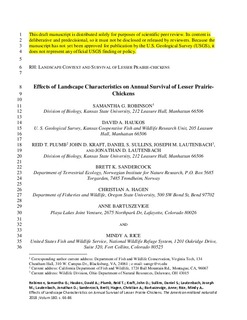Effects of Landscape Characteristics on Annual Survival of Lesser Prairie-Chickens
Robinson, Samantha G.; Haukos, David A.; Plumb, Reid T.; Kraft, John D.; Sullins, Daniel S.; Lautenbach, Joseph M.; Lautenbach, Jonathan D.; Sandercock, Brett; Hagen, Christian A.; Bartuszevige, Anne; Rice, Mindy A.
Journal article, Peer reviewed
Accepted version

Åpne
Permanent lenke
http://hdl.handle.net/11250/2559517Utgivelsesdato
2018Metadata
Vis full innførselSamlinger
- Publikasjoner fra CRIStin - NINA [2364]
- Scientific publications [1392]
Originalversjon
The American midland naturalist. 2018, 180 66-86.Sammendrag
Agriculture and development have caused landscape change throughout the southwestern Great Plains in the range of the lesser prairie-chicken (Tympanuchus pallidicinctus). Landscape alteration within the lesser prairie-chicken range may contribute to range contraction and population losses through decreases in survival rates. Our objectives were to determine if: (1) landscape configuration (i.e., the spatial arrangement of habitat) or composition (i.e., the amount of habitat), at the study-site scale, affected annual survival of females, (2) relationships exist between landscape context (i.e., landscape configuration and composition) and weekly survival to assess effects of landscape composition and configuration on lesser prairie-chicken populations, and (3) anthropogenic features influenced daily mortality risk. We captured 170 female lesser prairie-chickens and used very-high-frequency and GPS (Global Positioning System) transmitters to track their movement and survival for 2 y. We used known-fate survival models to test if landscape configuration or composition within three sites in Kansas were related to differences in female survival among sites. In addition we tested for relationships between weekly survival and landscape configuration or composition within home ranges. Finally, we used Andersen-Gill models to test the influence of distance to anthropogenic features on daily mortality risk. Differences in survival were evident between sites with differing landscape compositions as annual survival in Northwestern Kansas (ˆS ¼ 0.27) was half that of Clark County, Kansas (ˆS ¼0.56), which corresponded with 41.9% more grassland on the landscape in Clark County; landscape configuration did not measurably differ among sites. Survival was greater for prairie-chickens with home-ranges that had greater patch richness and in areas with 30% crop and 57% grassland. Female lesser prairie-chickens also experienced greater mortality risk closer to fences at patch edges. Further conversion of grassland landscapes occupied by lesser prairie-chickens should be avoided to reduce habitat loss and fragmentation thresholds that could affect survival. We suggest continued encouragement of Conservation Reserve Program enrollment in western areas of the lesser prairie-chicken range to maintain or increase the amount of grassland to increase annual survival.